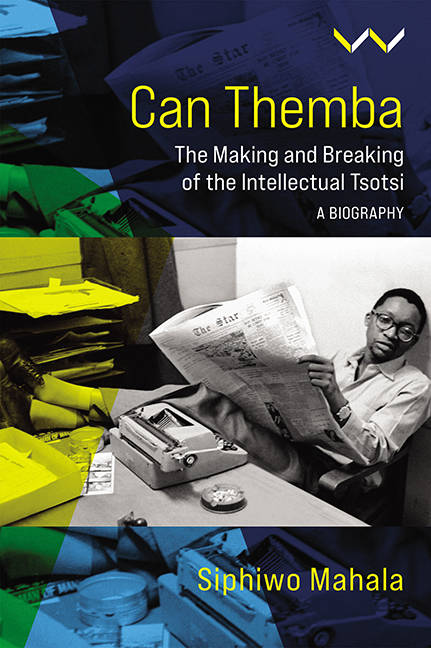Book contents
- Frontmatter
- Dedication
- Epigraph
- Contents
- List of Illustrations
- Acknowledgements
- Introduction
- PART I Death and Birth of a Scribe
- PART II ‘Live Fast and Die Young’
- PART III The ‘Intellectual Tsotsi’
- PART IV Dances with Texts: Writing and Storytelling
- PART V A Writer’s Immortality
- Postscript: The Three Burials of Can Themba
- Notes
- Bibliography
- Index
15 - The Suit for All Seasons
Published online by Cambridge University Press: 26 May 2022
- Frontmatter
- Dedication
- Epigraph
- Contents
- List of Illustrations
- Acknowledgements
- Introduction
- PART I Death and Birth of a Scribe
- PART II ‘Live Fast and Die Young’
- PART III The ‘Intellectual Tsotsi’
- PART IV Dances with Texts: Writing and Storytelling
- PART V A Writer’s Immortality
- Postscript: The Three Burials of Can Themba
- Notes
- Bibliography
- Index
Summary
He also didn't neglect the dramas of personal life and of love life, the erotic side of life. And of course, ‘The Suit’ is the most wonderful example of that … What punishment that the woman is left with a suit that a lover left quickly when the husband came home, but he did this – wickedly,but there was something very serious behind it.
Nadine Gordimer — Interview (2013)If we had to single out a sole literary output as the most impactful in constructing the image of an artist, for Can Themba that story would undoubtedly be ‘The Suit’. Notwithstanding the significance of all his other works, ‘The Suit’ stands out as the pinnacle of his literary oeuvre.
Intertextuality is an integral part of the writings and indeed the discourse of Themba. We have already seen, in the previous chapter, the extent to which he drew from and reinterpreted the works of others as a creative artist, intellectual, journalist and teacher. However, the converse is also true; his own writings have inspired adaptation and adoption in contemporary narratives and across genres, creating what might be called intergenerational dialogue across the decades. So far, ‘The Suit’ has been the most popular choice for experimentation, and has generated the most dynamic dialogue.
Intertextuality is an integral part of the writings and indeed the discourse of Themba. We have already seen, in the previous chapter, the extent to which he drew from and reinterpreted the works of others as a creative artist, intellectual, journalist and teacher. However, the converse is also true; his own writings have inspired adaptation and adoption in contemporary narratives and across genres, creating what might be called intergenerational dialogue across the decades. So far, ‘The Suit’ has been the most popular choice for experimentation, and has generated the most dynamic dialogue.
Themba's ‘The Suit’ has proved to be one of the most adaptable short stories ever written. This not only refers to cross-genre adaptation– it has been adapted for film, theatre and graphic comics – but includes intra-genre experimentation as well. This can be seen in the number of recent short stories that are in dialogue with ‘The Suit’, and continue to ‘write back’ to Can Themba. I am part of this discourse, and my own work will form part of my analysis in this chapter.
‘The Suit’ tells the story of a man, Philemon, who, acting on a tip-off from a neighbour, catches his wife (Matilda) in their marital bed with another man. The adulterer jumps out the window and escapes half-naked, leaving his suit behind. Instead of a predictably violent reaction, Philemon resorts to a psychological trick, using the presence of the suit in their home to punish Matilda. He forces his wife to treat the suit like a visitor, serving it food and carrying it with her when they walk in the streets.
- Type
- Chapter
- Information
- Can ThembaThe Making and Breaking of the Intellectual Tsotsi, a Biography, pp. 189 - 200Publisher: Wits University PressPrint publication year: 2022

